Welcome to FISH FOOD TIMES
Nov. 2015 issue No.143

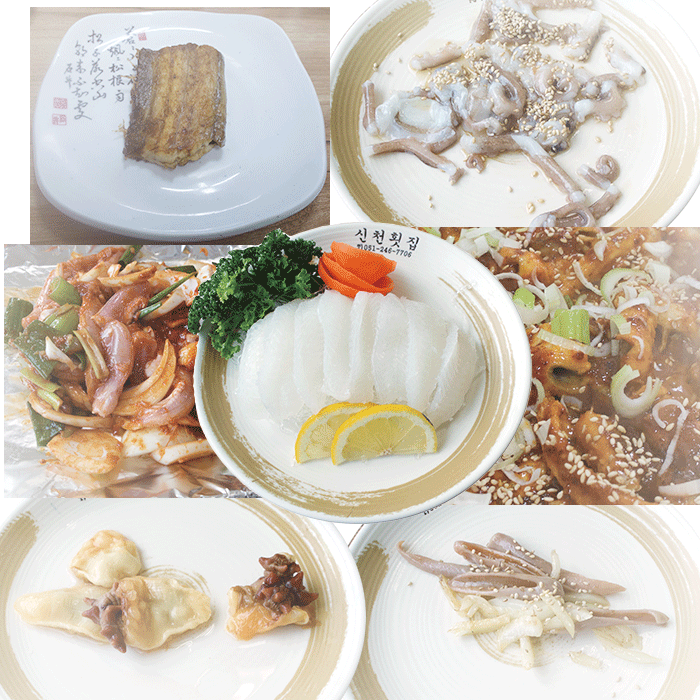
Difference in the fish meal across the sea
In October, I had the opportunity to go to Busan South Korea schedule of two days. Is a South Korean second largest city, yet in Busan, which is also a fishing port facing the sea, the one side of the fish circumstances that I experienced, although seems to be only a small one end of the Korean food culture, readers of FISH FOOD TIMES to all of you, I think I try to convey "information about Busan of fish."
Korean Air Lines, which flew the Fukuoka Airport to 11:15 is landed in just the 11:50 after 35 minutes Busan airport, it landed in a foreign country just to "a blink". This time is almost together with the time required to Kagoshima Airport from Fukuoka Airport, far such as the deep emotion that came to the land of all the way distant foreign country, it was equal to the feeling that has been going a little far away in the country.
Immigration procedures at Busan airport end to extremely simple, and boarded the limousine bus to 12:15, and then just to 13:15 after one hour I were able to finish the hotel check-in. This is not a feeling that came to very distant foreign country, Busan travel great speed feeling is was started.
The choice of hotel was in HOTEL HOAH adjacent to the from that the "walk to see Busan fish circumstances" is clear as a theme, famous as a fish market in Busan "Jagalchi fish market." There is only this hotel 50 rooms but the building was a small, top floor of the ninth floor of the room is a bright, clean and spacious, at the front it was comfortable because the Japanese also normally communicate.
A major location of Busan city has been almost written in Japanese, Japanese announcements are also broadcast in the subway of the main station, not that much trouble just Japanese in the main was the location. But if you go to a place that was secluded little there has been open that neither English nor Japanese no longer spoken.
Signboard other display products in Korea is almost 90 percent Hangul characters, displayed in Chinese characters and alphabetic characters is small. Although I felt embarrassment for the meaning of the Hangul characters I can not understand, in the one hand the Korean and Japanese conversation notebook, first, I walked into the biggest destination Jagalchi fish market.
We first attached to the eyes, it is the image of under looked through the glass of the hotel front side, it is because I did know well what was to be confirmed to go to near.
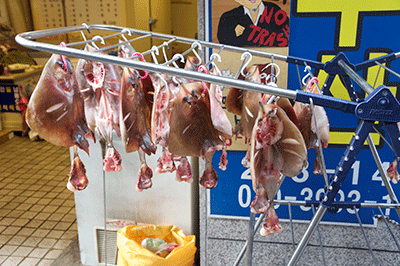
This was dried fish that are dried leaves the stingray fish figure.Small stingray that hollowed out the internal organs is hooked by something like as it is washing dried instrument, it had been the sun drying. The author is was supposed to taste suddenly exoticism from dried fish of stingray first saw.
But if think about it, dried fish stingray fin in Japan are sold in the country, boiled stingray fillets also not uncommon in such Kitakyushu region, small stingray suspended remains figure like this image was the only surprised a little by seen to be that.
If you walk to the Jagalchi fish market, is on the sidewalk there was a landscape myriad of stalls is in here and there, such as the image below.
This landscape is almost the same as those seen in Vietnam in Ho Chi Minh City, for the handling of fish, Korea and Vietnam was felt that's the same kind of thing.
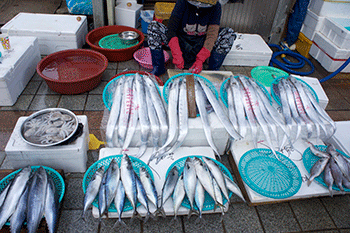
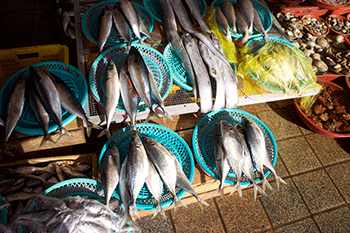
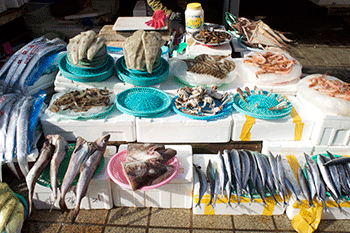
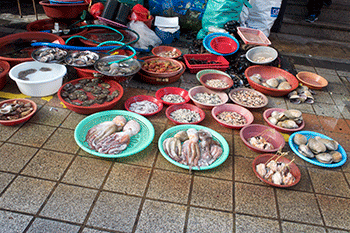
Many of the stalls as well as the sale of fish, many shops eateries format that can be eaten on the spot, that is an aunt who almost called ajime.
The time of the Korean War, gathered refugees and war widow in Busan, South Korea overseas people, we started from the fact that made the seafood of trading and processing in the stalls of Nampo-dong.
The presence of street vendors seems to have become a one time problem, but by the owners of the stalls in 1969 Formed Busan fish and shellfish processing union Institute, 3 floors building in 1970 on the landfill of coastal areas are construction, stalls it was developed as a market.
And in 2006, new Jagalchi market building, such as the image below in the sea side of the old building was opened.
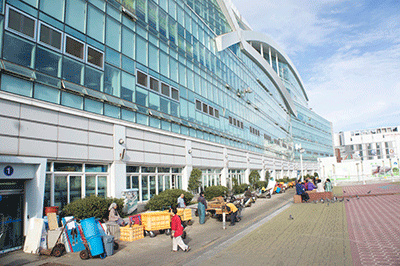
Passage on the first floor in this exists vertically long in three columns, a lot of the fishmonger's is in on both sides. Fishmonger's among the early morning assembles the business to the professional to the other party, and to then target the general customers have a business all day.
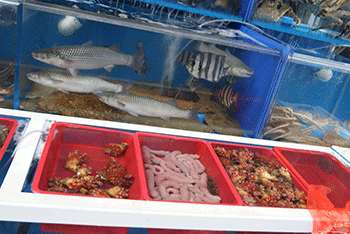
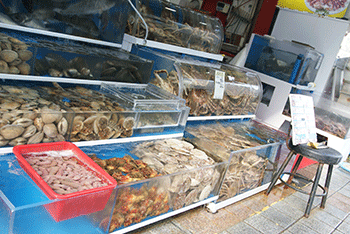
Most fish department in its is a live fish aquarium, seemed to be almost 90% are assembled the sale of fish only live fish and shellfish. But it's just part in, but the fish department, such as the "face-to-face sales floor of Japanese style" which was arranged the fresh fish on that paved the ice was also able to find several.
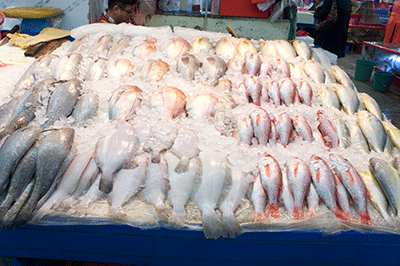
In the stalls, also in the fish market, anywhere had in common is that there is no "price tag", all fish prices seem to be told the price in a relative, in Korea "to see the people, then the selling price how determining "is as basic of business.
On the second floor of the fish market there is a the cafeteria to feed and bring the fish bought in the first floor of the fishmonger, there is a large bustle from the daytime. Japanese tourists to visit this market, cheap or you know not whether the price is high at the bottom of the fish in the Korean market, there is a possibility that has been in a sucker, may have been one of them the author and possibly .
In the case of the author, and the negotiations with the owner of the the cafeteria, because the requirement that "a variety of want to eat little fish" had been through, did not remain dissatisfied even if higher. To eat fish dishes at Jagalchi fish market, because it is set fee system, including such as pickles, it is better that had been prepared that it can not be so cheap.
Since I had arrived in Busan at lunch, it had been the sights of as Jagalchi market and impair eating lunch. Therefore eventually I took the meal which also serves lunch and dinner in the near time in the evening, but the fish that would not able to eat never anyway in Japan as the author, had decided to eat to choose in Korea.
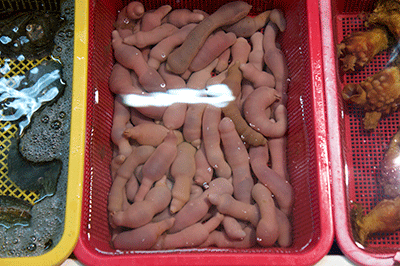
First of all this. Under the name "kebulu" in Korean, is a Japanese name "yumushi". Echiura Gate echiurid rope Echiuroinea Echiuridae is a marine invertebrate. Alias Koji, Lutz in Hokkaido, called II in Wakayama, in Kyushu has been called Iimara. Sashimi In such part of Hokkaido, vinegar miso, boiled, it seems to be edible, such as dried fish. And though anglers seems to exist that are well known in between also be used as fishing bait for black sea bream fishing anglers, I do not fishing has lived without knowing this is also non-study.
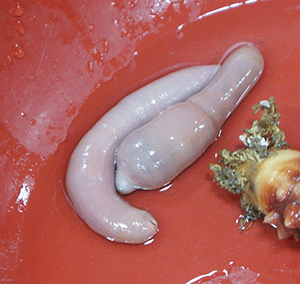
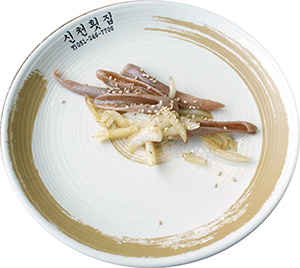
Two animals of Kebulu of the upper-left image that I asked is I came out and been to the right, such as cooking. In two or three of the vertical cutting out the internal organs, which is like the only of cooking fried lightly with the onion slices in the sesame oil, it was possible to feel slightly with the taste and texture that was crunchy.
The next Korean name Komujan'o of the following image. Japanese name is the most primitive group as invertebrates are called nutaunagi. In the strict sense, not the fish, and is treated as a convenience fish. Under the name derived from that slimy lot of mucus out of the body from the skin, as in Japan, had been originally classified as hagfish order hagfish family, including discriminatory terms to the visually impaired, in January 2007 next to names nutaunagi by the Japan Society of fish, hagfish as a kind of a history that has been changed to the current standard Japanese name that hosonutaunagi.
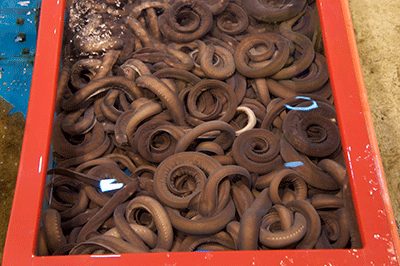
This is also the same as echiuroid and are sold while being harnessed in a water tank in this way.
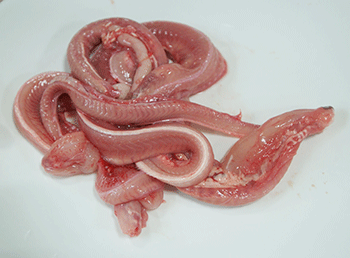
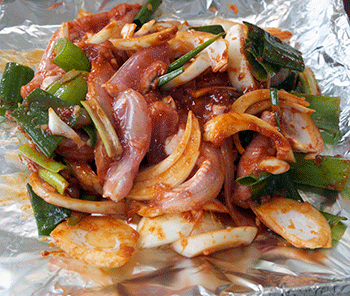
And although this is now coming out and the upper right image as cooking, stage of the previous under treatment they become like the upper left, little seen it was seemed like a big earthworm.
How to cook and put the knife to leave a little bit of skin in a part of the head, is peeled off pull the skin at once towards the tail, it is only to remove the internal organs.
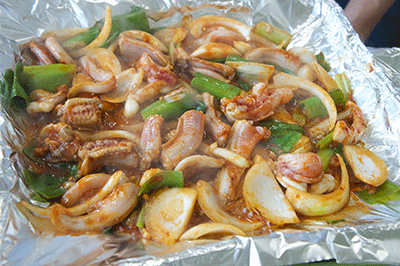
A while and are mixed with vegetables while cooked on an iron plate, red color, such as the first earthworm is eliminated, it became a color that at last increased appetite. Komujan'o are not riding fat also much without soft as Japanese eel, but there was a crunchy with a resilient, as unfortunately the taste is too strong spicy pepper, and finished to still taste itself is not sureI have had.
Is a luxury food Komujan'o had been used as a nourishing food of people a long time in South Korea, or to roast, or the grilled, disconnect whole like the image of the above with fried onion and red pepper paste to eat in the roasted meat style ordinary seems is. But that there is also a hagfish specialized restaurant in Korea.
In Japan, but is edible, such as grilled or dried fish in some areas such as the Nagasaki Prefecture and Niigata Prefecture, it is not distributed as almost edible nationwide. In Akita Prefecture and Niigata Prefecture made the hagfish edible processed products under the name of "beach grilled conger eel", also smoked and dried fish are produced.
In South Korea the surrounding waters, catches of Komujan'o is not decreased, also from Ishikawa Prefecture and Shimane Prefecture and Japan of various places and eating habits of Komujan'o there is no America Maine, exports to South Korea have been actively carried out.Hagfish of leather is called Eel skin (eel skin), it is distributed from why it is supple there is strength than cow leather has a distinctive pattern, as such purse luxury leather goods made with eel skin in Korea and the United States .
The following is a kleptomaniac octopus and sea squirts and wrasse.
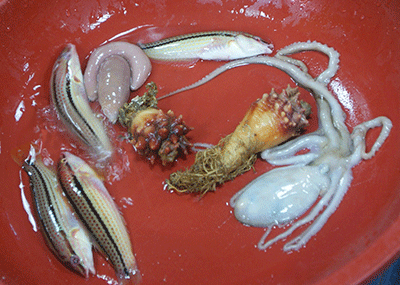
These are expressed to be a way of eating that "sashimi", the official in South Korea seems there is pronounce words with "Fe" that of sashimi. It is that cook in sashimi, since was determined that the thing put out in the cuisine remains "raw", showed me the state of cooking.
First long-armed octopus, it is washed with water the whole if you take the internal organs with a finger, then cut by hitting it with a kitchen knife on a cutting board. And because only sprinkle this suitably the sesame oil and put on top of the dish, it is completed in a sleight of several tens of seconds of things.
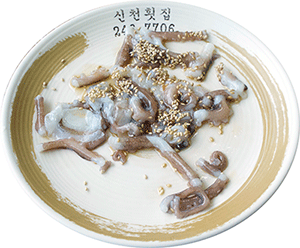
Next sea squirts. After removing off the part, such as the roots of the plant with a kitchen knife, strip the outer peel, then to clean so as to sharpen the squirts of internal organs with a kitchen knife in the process of the double doors technique. Finally this is ending as it is placed on a dish. This also a few tens of seconds.
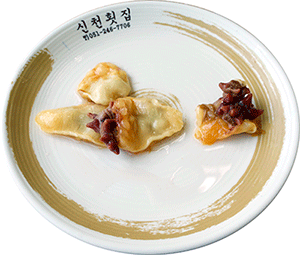
Finally, it is wrasse.
This was one of the harvest of this trip to Korea became a study for the author.
Since the wrasse was 4 fish, but could not in indeed several tens of seconds, still no doubt that it was within 2 minutes from 1 minute.
When the method referred to what to do, ①, placed on a cutting board the wrasse, a belly front, with the head to the right, to meuchi to eyeball portion. ②, it puts the cut next to the gill lid of wrasse.As it is going to slide in Daimyooroshi technique toward the kitchen knife to tail fin (will be easy to understand and think of the manner of small horse mackerel) ③, it does not complete the three pieces dismantling, to stop the knife at the brink of the tail fin, skin only that with, it turns over towards the left side of the tail fin. ④, the original of the body to the right, place the only remains that led the peel to the left, to separate the peel and the body is moved to the left as it is a kitchen knife in the manner of Uchibiki. ⑤, in order to make the cooking of the upper body side now, towards the belly towards the other side, head remains right, repeating the same thing as before, three pieces dismantling and peel like is completed. ⑥, it is the last in the end to take scooping the belly bone with a kitchen knife.
And to repeat the dismantling of four fish this, I've surprised because the two minutes did not take.
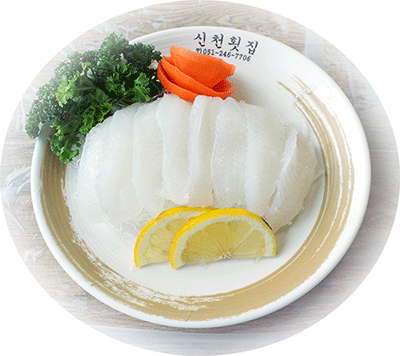
And sashimi that has been carried as cuisine is an image of the above, in the ordered food was the most Japanese sashimi style. Is heaping the purpose in the "seaweed Vidro" that sashimi tuma artificial radish Ken wind put the volume, wrasse of half the body had been dish as it is 4 fish worth on it.
I have ordered in these dishes, this addition to flounder of nigiri sushi is 2 Kan, boil shrimp 2 fish, slices sashimi 2 of octopus that has been boiled, with small plates of Chinese cabbage kimchi is a set, and finally the fish finish Ara soup have been carried to the table.
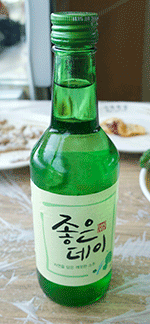
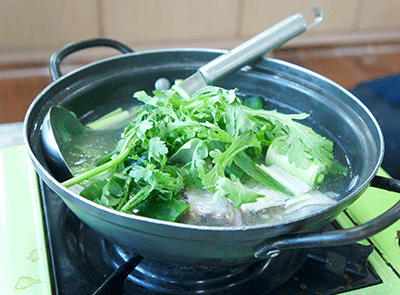
Fish soup is only drank mouthful, but most were untouched, Alcohol 16.5% of shochu is easy to drink, I've drank a 500ml.
And because it was total 43,000W (won) to be included to shochu, amount of money is calculated in Japanese yen exchange rate in the last becomes the yen 4,562. As meals for one person, do you think the cheap Do you think high this, it is, but I think each person, as as the contents of the set I, of flounder nigiri sushi 2 Kan and boiled shrimp 2 fish and boiled the octopus sashimi 2 pieces, etc. I thought it was unnecessary. But this has to be expressed satisfaction according to the "if placed in the township follow the township" because as those that meal method of "Korea flow".
After finishing the meal, the day Jagalchi near market darkened sink, author but he was a walk in tipsy mood, even if the day falls, stalls and stalls were still booming. Compared to the "morning bustle and evening lonely situation" in the vicinity of the fish market in Japan is without a marked contrast, Jagalchi market seemed unchanged bustle from morning till night.
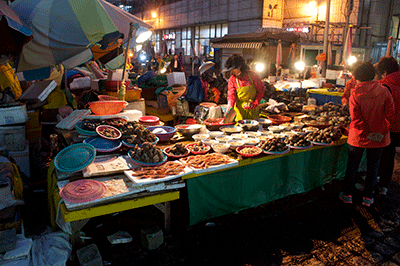
Next page, continues to Day 2,
Continued on next page


An opinion and the communication are to iinfo@fish food times
Date of updating Nov.1, 2015
